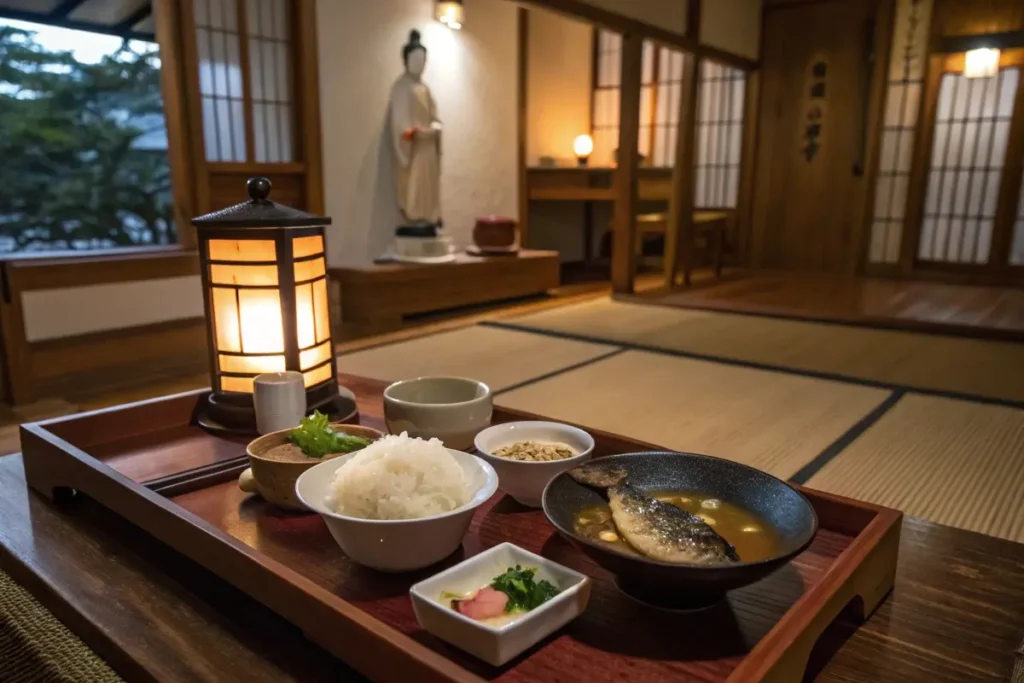Shintoism—Japan’s indigenous belief system—permeates many aspects of Japanese culture, from ancient rituals to modern-day festivities. But does shinto effect japanese food? You might be surprised to learn how the respect for nature, purification rites, and sacred festivals in Shintoism influence how some Japanese approach their diets.
While there isn’t a single “forbidden” food in Shinto akin to dietary rules in certain other religions, Shinto’s emphasis on purity, seasonality, and gratitude toward natural resources quietly shapes the way many Japanese think about cooking and eating. In this comprehensive article, we’ll explore how Shintoism affects Japanese culture, whether religion affects food in Japan, and what foods, if any, are forbidden in Shintoism. We’ll also uncover how Shinto ideals like harvest celebration and ritual purity manifest in various Japanese dishes.
For those who’d like to understand more about how Japanese cuisine is guided by deeper cultural currents, feel free to browse our Best Japanese Foods page. It showcases iconic dishes that reflect Japan’s longstanding reverence for fresh, high-quality ingredients, which partly owes its roots to the Shinto ethos. Let’s begin by examining the bedrock principles of Shinto and how they subtly guide Japan’s culinary habits.
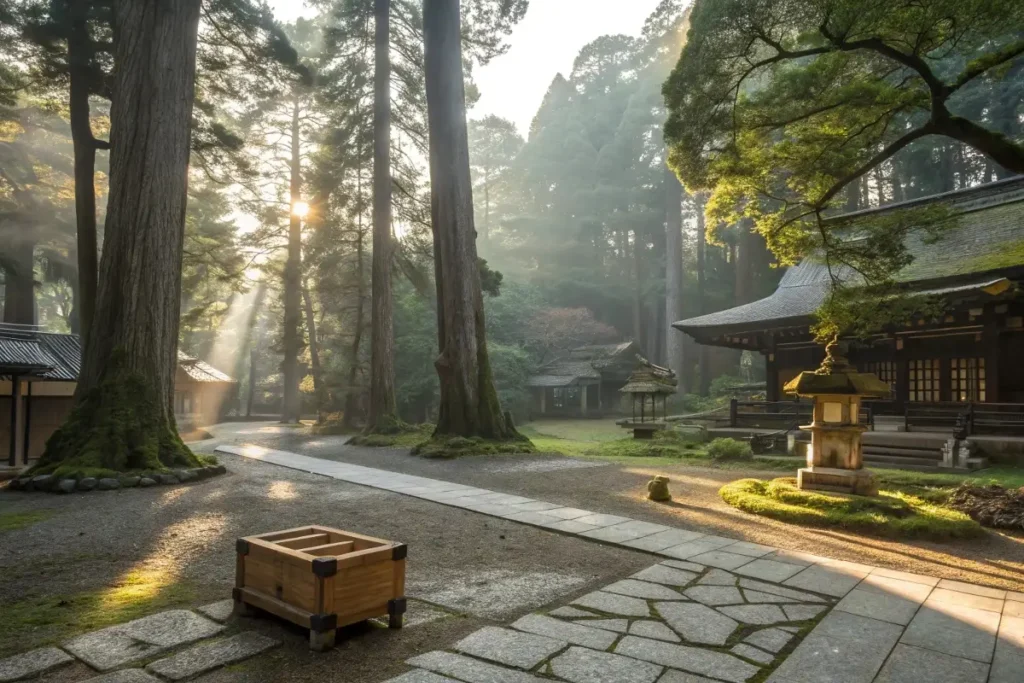
Core Principles of Shinto and Food in Japan
Understanding Shinto’s Nature-Centric Beliefs
Shinto, often defined as “the way of the gods,” is a polytheistic faith deeply grounded in natural elements and ancestral veneration. In Shinto belief, kami—spirits or deities—reside in natural phenomena like mountains, rivers, and forests, as well as in revered ancestors. This worldview fosters respect for life’s interconnectedness and for nature’s bounty. When we ask does shinto effect japanese food, the answer traces back to this foundation: if all resources, including plants and animals, are imbued with spiritual essence, they deserve mindful, even ritualistic handling.
How Religion Affects Food in Japan
While modern Japan is largely secular in daily routines, Shinto traditions still influence certain habits:
- Purification and Cleanliness: Before entering shrines, visitors perform purification rituals like rinsing hands and mouth. This sense of ritual purity can extend to how chefs handle ingredients—washing produce meticulously or adopting minimal, “clean” seasonings that highlight natural flavors.
- Seasonality and Freshness: Shinto’s regard for natural cycles encourages seasonal eating. Japanese cooks prize produce at its peak, celebrating ephemeral flavors in dishes like takenoko gohan (bamboo shoot rice) in spring or matsutake mushrooms in autumn.
- Gratitude Toward Food: Shinto rituals emphasize thankfulness for harvests. Many Japanese utter itadakimasu (“I humbly receive”) before meals, acknowledging the spiritual and physical sources of the meal.
Minimal Dietary Restrictions
One might assume that Shintoism would forbid certain foods, but historically, Shinto does not have explicit “haram” or “kosher” equivalents. That said, aspects of Buddhism’s vegetarian or pescatarian leanings intermingled with Shinto beliefs, especially during the Edo period. As a result, the Japanese historically consumed less meat for centuries—although not due to a strict Shinto ban, but a combined cultural ethos. Today, what can’t Shintos eat? is less about an official rule and more about personal or local tradition.
Overcoming Western Misconceptions
Outside Japan, there’s a notion that “religion always dictates food rules.” In the case of Shinto, it’s more about spiritual alignment with nature and gratitude rather than imposing strict dietary laws. Many Japanese eat pork, beef, or any other protein. Still, certain festivals might see symbolic or ritual foods offered at shrines—like kagami mochi (decorative rice cakes for New Year). These items connect worshippers to the kami, bridging everyday meals with spirituality.
For those seeking recipes that embrace nature’s bounty without explicit religious constraints, consider browsing our Japanese Vegetarian Recipes for plant-forward dishes that reflect Japan’s appreciation for fresh, wholesome produce. This synergy of minimalism, seasonality, and reverence exemplifies how Shinto’s gentle influence saturates Japanese food culture, even if no official religious dietary code exists.
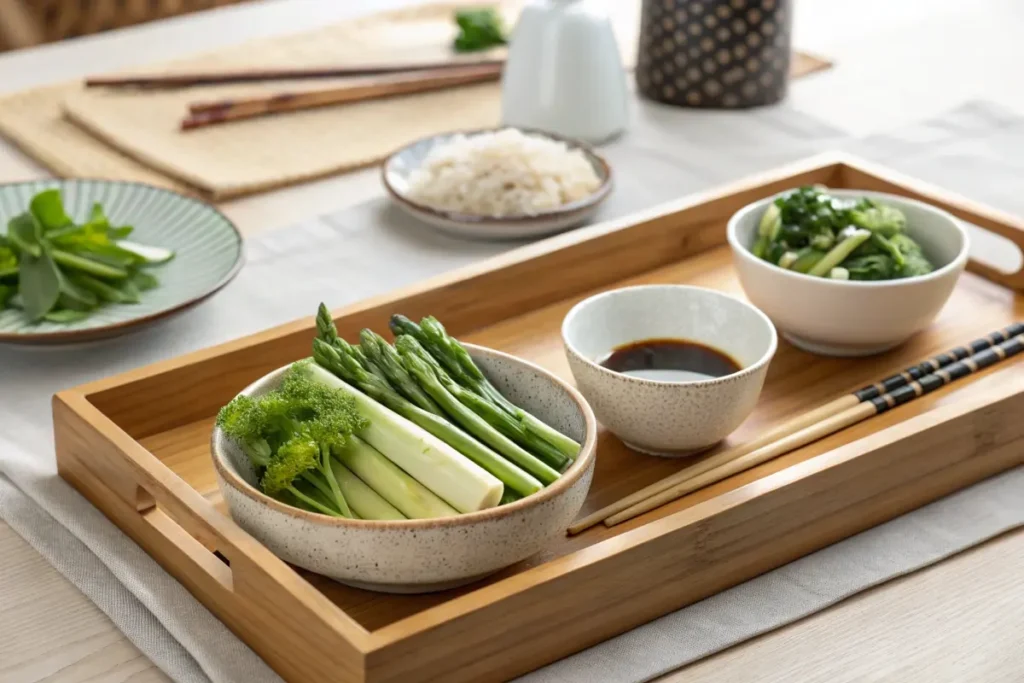
Historical Evolution of Shinto’s Food Customs
Ancient Harvest Festivals and Offerings
In early Japan, agrarian communities held frequent rituals to appease local deities controlling weather, crops, and water. These events—like Niiname-sai (the harvest festival)—involved presenting new rice and produce to the Emperor and deities, thanking them for agricultural abundance. Over time, these offerings became symbolic prototypes for how the Japanese appreciate and prepare food even outside shrines.
- Rice as Sacred: As a core Shinto element, rice exemplified life’s essence. In old harvest rites, people offered pristine rice or sake (fermented rice wine) to the kami, bridging the spiritual and earthly realms.
Interplay with Buddhism and Other Influences
During the Asuka and Nara periods (6th–8th centuries), Buddhism entered Japan, influencing dietary norms. Some emperors adopted bans on meat-eating to align with Buddhist precepts, yet these edicts were often short-lived or selectively enforced. Shinto’s fluid nature allowed it to coexist with Buddhist vegetarian ideals, producing a cultural mosaic where fish and certain vegetables took precedence over red meat for centuries.
Edo Period Meat Regulations
Although not strictly due to Shinto, a cultural aversion to consuming four-legged animals persisted for a significant part of Japan’s history. People believed land animals carried stronger odors or impurities, and Shinto’s purity concept reinforced the idea that strong smells might hamper spiritual cleanliness. As Japan opened to Western nations in the Meiji era (late 19th century), attitudes towards meat consumption changed. Yet some older generations still refrained from or limited meat, partially influenced by Shinto-Buddhist morality about harming creatures unnecessarily.
Contemporary Practices
In modern Japan, Shinto’s effect is more subtle than prescriptive. People might celebrate new harvests with special omizutori ceremonies or kagura dances at shrines, acknowledging nature’s gifts. Particular shrines produce specialized offerings—for instance, Miso from certain temple-run breweries. The act of “purification” can appear in how chefs handle ingredients: many wash them thoroughly or present them simply, reflecting a desire not to overshadow nature’s innate qualities.
- Ceremonial Dishes: On certain shrine anniversaries, you might find large communal pots of oshiruko (sweet azuki soup) served to visitors, free of charge. The communal act underscores togetherness and the spiritual dimension of sharing food.
- Minimal Waste Ethos: Tied to the idea of respecting all life, many Japanese cooks strive to use every edible part of an ingredient, limiting waste in a style reminiscent of nose-to-tail or root-to-stem cooking.
If you’re curious about how these historical layers manifest in actual recipes, see our Japanese Radish Recipe for a root often revered for its cleansing properties. Even if the direct link to Shinto isn’t always explicit, the ethos of respecting each ingredient remains deeply ingrained.
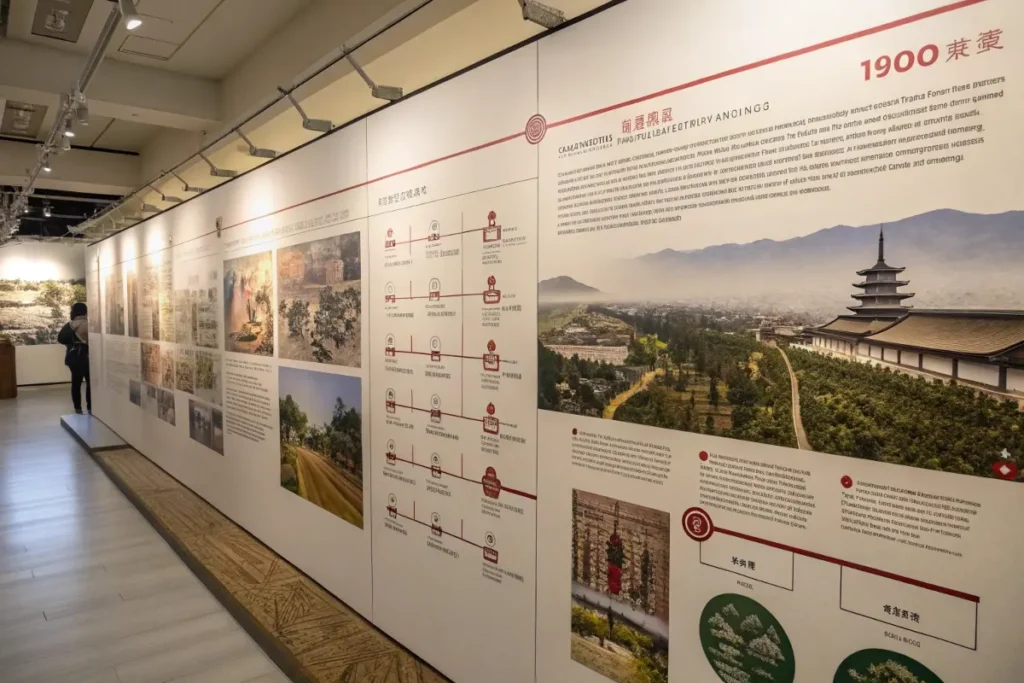
The Shinto Influence in Modern Japanese Cuisine
Emphasis on Seasonal and Locally Sourced Ingredients
The Shinto worldview perceives every living thing as part of a sacred ecosystem. Modern Japanese cuisine reflects this by championing fresh, in-season, often locally grown ingredients. Chefs rely on kikkō shoku (seasonal color motifs) to design dishes with vibrant produce—for instance, pairing green and red components in spring, or orange-brown in autumn. This concept extends beyond pure aesthetics: it’s a testament to how does shinto effect japanese food still resonates in everyday kitchens.
- Local Prefecture Specialties: Many prefectures highlight unique produce as a regional identity. For instance, Kyoto fosters a tradition of vegetable dishes known as Kyoyasai. Shinto’s love for the local environment is partly behind why these prefectures champion homegrown produce, maintaining soil health and heritage seeds.
Ceremonial Dishes and Community Festivals
- Matsuri Food Stalls: During Shinto festivals (matsuri), you’ll see street stalls selling yakitori (grilled chicken skewers), takoyaki (octopus balls), and more. While these are street foods, the communal vibe and blessing for a successful festival tie back to ancient offerings to the gods.
- Rice-based Celebrations: Shinto shrines might host events distributing mochi or shōjin ryōri-inspired meals (though shōjin ryōri is more Buddhist). The concept of feeding participants free temple or shrine-cooked meals fosters unity and thanks the kami for the harvest.
Subtle Purity Norms
One aspect of Shinto often overlooked is the notion of impurity or pollution (kegare). Modern chefs might not publicly label practices as Shinto, but parallels remain:
- Hand-Washing Rituals: Many Japanese cooking classes or restaurants emphasize thorough cleansing of hands and workspace, paralleling the broader cultural norm of purification.
- Removal of Blood or Strong Odors: In butchering fish or meat, the Japanese method often emphasizes immediate cleaning or draining to ensure a less pungent final dish. While not explicitly “Shinto law,” it reflects a cultural aversion to anything unclean or smelly in a spiritual sense.
Substitutions and Creativity
- Vegetarian Options: Even though what can’t shintos eat? isn’t codified, some devout or traditional individuals might refrain from certain meats, leading to creative vegetarian alternatives. Tofu, natto, or konnyaku can mimic textures in a meal, maintaining umami depth. Our Vegan Japanese Recipes showcase how plant-based dishes align with Shinto’s gentle environmental mindfulness.
- Minimizing Additives: Restaurants that highlight “natural flavors” or “no artificial additives” embody a Shinto-esque respect for what nature provides. They preserve the ingredient’s essence, using minimal condiments or cooking techniques that mask its purity.
Occasional Ritualistic Observances
In certain high-end establishments or traditional families, you might encounter small Shinto altars or talismans in the kitchen—a subtle gesture seeking blessings for successful cooking and customer satisfaction. It’s not overt or universal, but a quiet tradition acknowledging food as a spiritual gift.
To see real-life Japanese cooking approaches that might reflect this spirit, check out our Japanese Chicken Fried Rice Recipe. Notice how each ingredient’s flavor is balanced and showcased rather than overpowered, echoing Shinto’s reverence for nature’s inherent goodness.
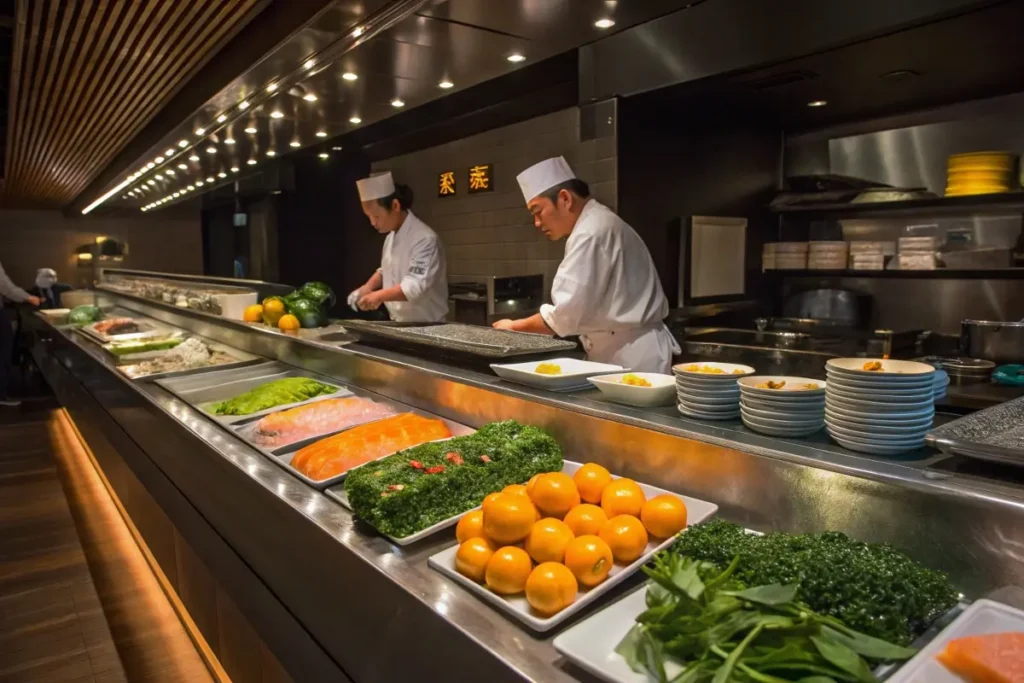
History and Examples
Ancient Temple Offerings and Imperial Court Dining
Long before Western influences, the Japanese Imperial Court orchestrated lavish banquets for aristocrats, especially around Shinto festivals. These early feasts included multiple courses of vegetable and fish-based dishes, reflective of environmental abundance. Court records mention the careful selection of color combinations—green (mountain vegetables), red (fish roe, prawn), white (daikon radish)—mirroring Shinto ideals of harmony with nature.
Example: Toshikoshi Soba
While not purely Shinto in origin, the year-end tradition of eating buckwheat noodles (soba) resonates with purification for the new year, discarding the old and welcoming the fresh cycle. Soba’s simple form and watery broth represent humility and the passing of time—ideas that dovetail with Shinto concepts of renewal. Though widely considered secular now, the underlying notion of spiritual transition is distinctly Shinto-Buddhist in nature.
Community Harvest Celebrations
In some rural areas, community members still gather at local shrines to present the first harvest—rice, vegetables, or fruit. Kagura performances or mikoshi (portable shrines) processions often occur. Food served at these events typically spotlights local staples: grilled fish from the river or region-specific produce. By partaking in these communal meals, participants symbolically unite with the kami, ensuring continued blessings on their crops.
Example: Hōnensai (Fertility Festival)
At certain shrines, fertility or harvest festivals can feature unique, sometimes eye-catching parades and symbolic objects. The local foods—be it sweet dumplings or sake—get special blessings, reinforcing the Shinto idea that ingesting these offerings fosters communal prosperity. Shinto, in this context, merges the spiritual with the culinary, albeit often overshadowed by the festival’s flamboyant aspects.
Modern Adaptations
In contemporary times, younger generations may not strictly observe old Shinto food customs. However, many still maintain a mindful approach to ingredients, echoing Shinto’s respect for the environment. Social media shows a rise in interest around “farm-to-table” and “slow food” movements in Japan. These movements often mirror the gratitude and respect for life championed by Shinto. Chefs highlight local fisheries, ethically sourced produce, and minimal-waste cooking. These practices link back to spiritual beliefs about living in harmony with nature’s resources.
For a closer look at how tradition meets innovation in modern Japanese sweets, you might enjoy our Traditional Japanese Desserts Recipe. Many of these confections, such as sweet bean paste or mochi, are integral to festivals and can be included in shrine offerings. Their symbolic shapes and colors sometimes reflect Shinto’s historical emphasis on beauty and harmony, carried forward into the present day.
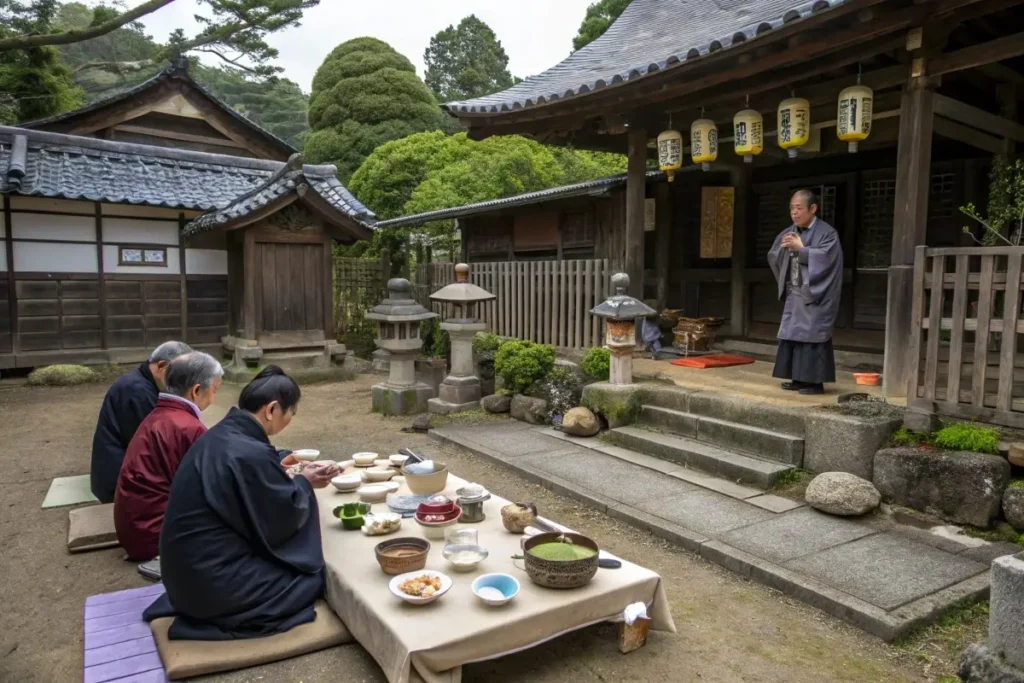
Practical Examples/Use Cases
When exploring does shinto effect japanese food, it helps to view everyday scenarios demonstrating Shinto’s subtle but present impact. While no explicit commandments govern dietary choices, these real-world examples illustrate how Shinto’s ethos infiltrates daily life in small, practical ways.
1. Family Kitchen with Seasonal Rotations
- Scenario: A Tokyo-based family attempts to cook in sync with the Shinto-influenced concept of seasonal produce.
- Implementation: In spring, they focus on bamboo shoots and sansai (mountain vegetables). In autumn, they highlight chestnuts, mushrooms, and sweet potatoes.
- Benefit: The family experiences more varied diets year-round, and kids learn respect for nature’s cycles.
2. Local Festival Food Stall
- Scenario: During a matsuri, a local fish vendor sets up a stall selling grilled freshwater fish, a nod to Shinto’s reverence for local rivers.
- Implementation: The vendor might place a small paper talisman from the shrine above the grill, hoping for prosperous sales.
- Benefit: Shinto elements unify commerce, spirituality, and community fun.
3. Shinto-Inspired Corporate Luncheon
- Scenario: A large Japanese corporation hosts an annual event for staff, wanting to incorporate cultural traditions.
- Implementation: They arrange a buffet featuring “purifying” dishes like clear broth soups and fresh vegetables, plus a sake toast to the company’s success.
- Benefit: The meal fosters corporate unity, lightly referencing Shinto-inspired well-wishes for collective well-being.
4. Eco-Focused Chefs and Minimal Waste
- Scenario: Younger chefs open a bistro focusing on local, organic produce and near-zero waste.
- Implementation: They design a menu that uses vegetable scraps in stocks, composting inedible parts, echoing the Shinto value of honoring nature.
- Benefit: This practice resonates with increasingly environmental-minded diners, blending ancient spirituality with contemporary sustainability.
For more creative ways to integrate these principles, see our Japanese Cucumber Salad Recipe for a refreshing dish that honors the purity and simplicity central to Shinto sensibilities. By emphasizing minimal processing and fresh produce, it resonates with the belief that nature’s gifts should be minimally altered, preserving inherent life essence.
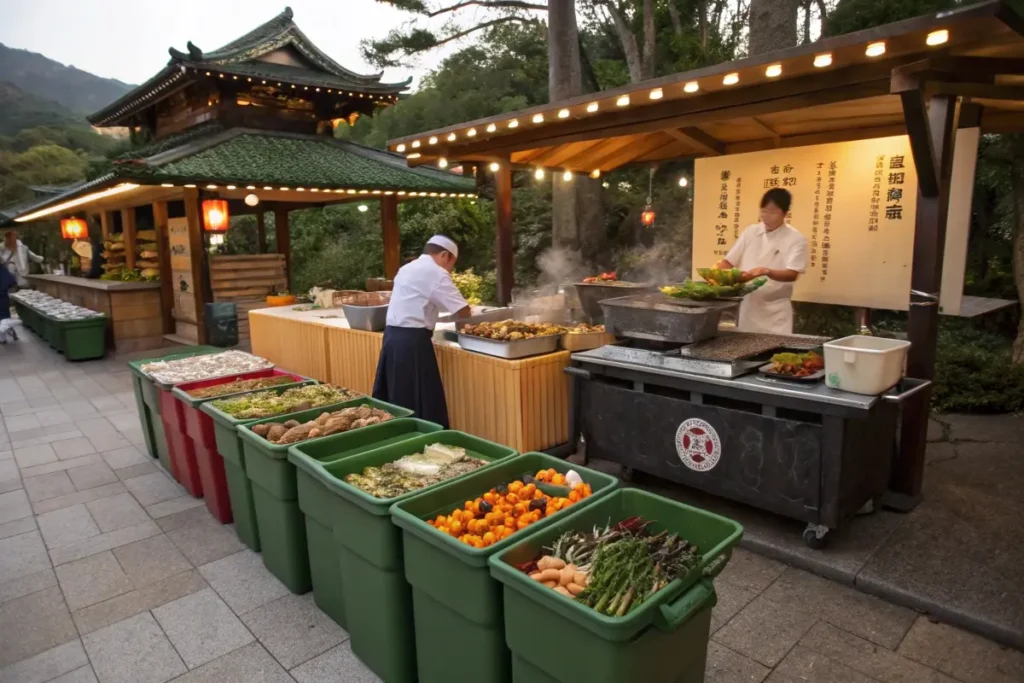
FAQs
Below, we address frequently asked questions on does shinto effect japanese food, clarifying the scope and boundaries of Shinto’s culinary influence.
- How does Shintoism affect Japanese culture?
Shinto underpins much of Japan’s societal fabric, from etiquette and seasonal festivals to art and architecture. It promotes harmony with nature, gratitude toward resources, and a belief that kami (spirits) inhabit all things—fostering a mindset of respect, which can extend to cooking and eating. - Does religion affect food in Japan?
Yes, but less rigidly than in religions with explicit dietary laws. Shinto and Buddhism historically shaped cultural attitudes, encouraging minimal waste, seasonality, and respect for life. However, no official Shinto “diet” forbids or mandates particular items universally. - What can’t Shintos eat?
Shinto itself imposes no comprehensive taboo on specific foods. Historically, some Shinto-Buddhist influences led to reduced meat consumption. But modern Japan sees all sorts of foods widely eaten. Purity concerns revolve more around cleanliness and odor than a ban on meat.
What food is forbidden in Shintoism?
- Strictly speaking, none. Shinto, as a belief system, doesn’t contain a formal list of prohibited foods. Instead, it emphasizes purity, seasonality, and a spiritual connection to nature. If individuals choose vegetarian or pescatarian diets, it’s more cultural or personal preference.
- Are there special Shinto dishes for ceremonies?
At shrines, offerings might include rice, sake, fruits, or fish. Some festivals provide communal dishes (like mochi soup) blessed by priests. However, these foods are for celebrations or spiritual significance rather than an everyday dietary rule. - How can I incorporate Shinto-based respect into my cooking?
Focus on fresh, local, and seasonal ingredients. Minimize waste by using entire produce when possible. Approach your ingredients with gratitude—like saying itadakimasu before meals—to honor the life that sustains you. - Do Japanese restaurants reflect Shinto influences?
Indirectly, yes. Many emphasize seasonal menus, minimal over-spicing, and high-quality, aesthetically pleasing ingredients. The notion that each dish should highlight nature’s bounty ties into Shinto’s outlook, even if owners don’t explicitly state it as “Shinto.”
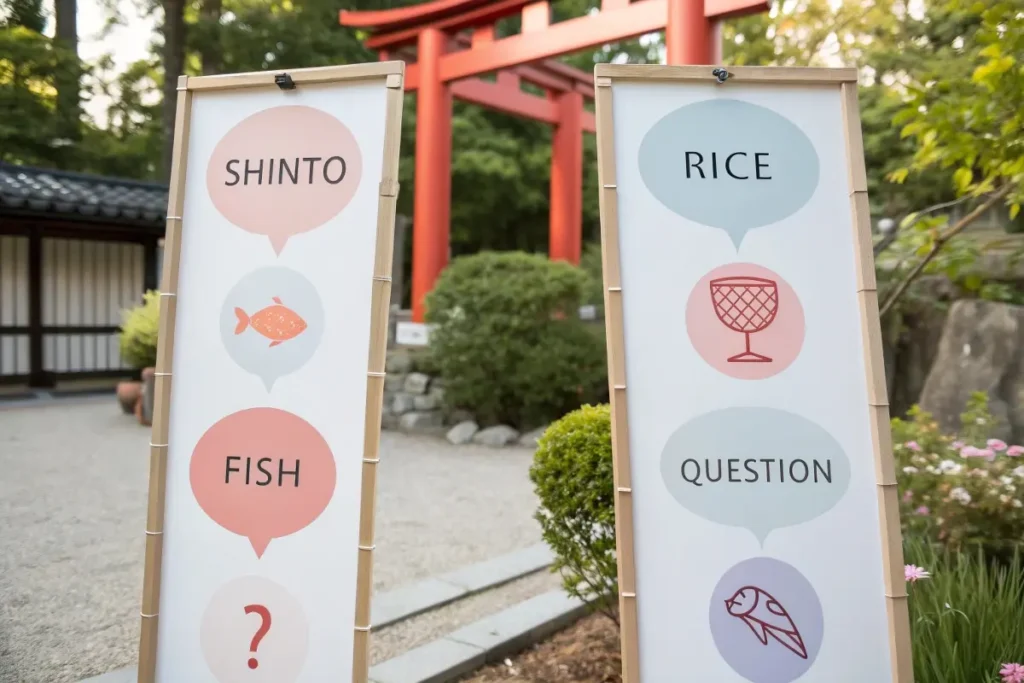
Conclusion
While Shinto’s effect on Japanese food might not yield a definitive list of do’s and don’ts, it’s clear that Shinto ideas about nature, purity, and gratitude influence many aspects of Japanese culinary tradition. Rather than imposing rigid regulations, Shinto provides soft guidance. This manifests as respect for high-quality local ingredients, minimal waste, and season-driven, balanced menus. Historical influences, such as offering harvests at shrines and the concept of kegare (impurity), still appear in modern kitchens and festivals.
At its core, Shinto frames food as more than mere sustenance. Each dish symbolizes a harmony between humans and the kami, nourishing not just the body but also forging a connection to the environment. Whether you’re enjoying a hearty winter nabe or picking up fresh produce at a local farmers’ market, you’re partaking in a cultural legacy that upholds the spiritual dimension of everyday life. If you’re eager to explore more about Japanese gastronomy, visit our Discover Japanese Recipes page to find dishes that mirror the Shinto emphasis on simplicity and reverence.
In the end, Shinto’s effect on Japanese food may be subtle. No strict “forbidden foods” exist. However, it remains a compelling reminder that every morsel carries both physical and spiritual significance. This layered perspective elevates the act of cooking and eating into a mindful, almost sacred experience. It is an experience that continues to shape Japan’s culinary identity to this day.
